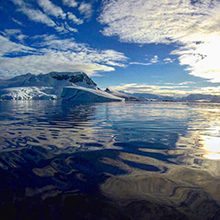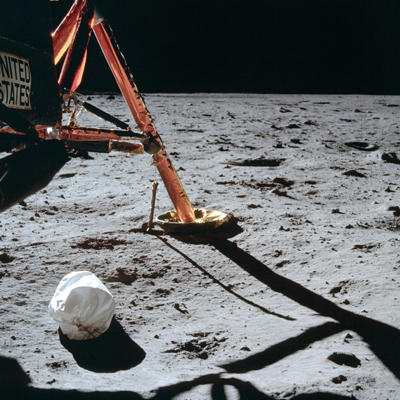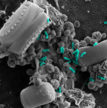Microbes and where to find them
Issue: Why Microbiology Matters
05 May 2020 article

Microbes are found in a diverse range of environments and contribute to many essential environmental processes. This section introduces some of the many microbes that thrive in niches around the globe and considers how microbes could exist outside of our world.
Microbes at extremes
Katherine Duncan
Antarctic ice-sheets and ancient geological rocks from other planets are examples of fascinating and extreme ecosystems used to study life. However, when considering the breadth of physical and chemical parameters, almost any environment can become extreme by tweaking even one variable. These extreme microbial environments can include thermophiles thriving in compost heaps, bacteria under enormous pressure on the sea floor, our own microbiota at low pH in the stomach, heavy-metal-adapted strains in mines and fungi surviving extreme radiation in Chernobyl.
Understanding the boundaries in which life can not only exist, but thrive, can aid our understanding of microbial adaption through genomic and metabolic processes. Although the environments are extreme, understanding these processes can have wide-ranging applications. Some examples include understanding anthropogenic impacts on the environment, improving biotechnological processes and studying the evolutionary mechanisms that lead to new biological and chemical diversity.
Microbes living at the extremes are testing out possibilities and carving out a niche to survive. These microbial pioneers are pushing limits; as a microbiologist the questions are exciting, challenging and represent a fascinating world of discovery.

Katherine Duncan
Strathclyde Institute of Pharmacy and Biomedical Sciences, University of Strathclyde, 141 Cathedral Street, Glasgow G4 0RE, UK
[email protected]
@kate_duncan
medicinesfromthesea.com
Katherine (Kate) Duncan has completed an MChem (Scotland and Florida), PhD (Biomedical Sciences, Canada) and two postdoctoral fellowships (Marine Biomedicine, University of California, USA, and Scottish Marine Institute, UK) all focused on marine natural products. In 2016, she started her research group, combining genomics and metabolomics to understand the chemical language of marine microbes and what influences it. Kate is a member of the Society’s Prokaryotic Division (environmental microbiology).
Why does microbiology matter?
Micro-organisms are a fundamental component of every ecosystem on the planet.
What qualifications did you obtain before starting this role?
I have a master’s degree in Chemistry (MChem, University of Aberdeen) with an international placement (Florida) focused on marine natural products. Following this, I decided to learn molecular biology and microbiology and completed a four-year PhD in Biomedical Sciences (University of Prince Edward Island, Canada). I then completed two postdoctoral fellowships, the first in Marine Biomedicine at Scripps Institution of Oceanography, University of California San Diego, and a second in Marine Biodiscovery at the Scottish Marine Institute.
Extreme bacteria in supporting human space exploration and the future of habitats on the Moon and Mars
Mara Leite
As we celebrated the 50th anniversary of the Moon landing this past year, another historical milestone for humanity is on the horizon. Different space agencies are preparing for long-term human presence on other planetary bodies. There are several convincing arguments to pursue this goal. Among these are technological advances and scientific knowledge, economic interests, as well as human ambition and curiosity.
Due to their proximity to Earth, both the Moon and Mars are the main targets for the establishment of permanent human colonies. The European Space Agency (ESA) has already expressed interest in building a moon village, and, more recently, the National Aeronautics and Space Administration (NASA) has created the Artemis program, aiming to take humans back to the Moon in the next decade, followed by crewed missions to Mars in the 2030s. Furthermore, countries such as China and Russia, and private companies, like SpaceX, are also expanding their space programs with similar intents.
Human settlement in space
The first steps of a human settlement involve the construction of habitats that can protect crew members from high doses of radiation and significant temperature fluctuations, while simultaneously providing a breathable atmosphere. Proposed designs have included a variety of materials. Some ideas incorporate inflatable subterranean modules, ice houses, and 3D printed structures using thermoplastics and local regolith (a mixture of dust and broken rock present on the surface of terrestrial planets and moons). The use of local (lunar and Martian) resources, also known as in situ resource utilisation (ISRU), is gaining momentum.
One of the biggest challenges in deep-space exploration is the cost related to the number and mass of consumables needing to be transported from Earth. Adapting to using native resources and recycling these resources will be pivotal in reducing mission costs. Habitats will be supplied with life-support systems – a combination of instruments that can provide an artificial Earth environment. These systems will rely on extreme bacteria to recycle human waste into valuable products, such as oxygen and water.
Extremophiles as model organisms
Extreme micro-organisms live in environments that are inhospitable to humans. Notable examples of these habitats include hot springs and hydrothermal vents. Extremophiles, as they are commonly known, are classified according to the environmental parameters in which they thrive. These parameters range from physical to chemical, and cover temperature, pH and radiation, among others. For instance, thermophiles, such as Thermus aquaticus, proliferate in high temperatures, while Thiobacillus acidophilus and other acidophiles flourish in acidic environments.
In the field of astrobiology, extremophiles are used as model organisms for extraterrestrial life. They can identify the range of conditions where life can be found and pinpoint locations that might potentially harbour micro-organisms. In this discipline, extremophiles can also help us to understand how life emerged and assist humans surviving in hostile conditions, like the ones present on the Moon and Mars. The rise of oxygen during the Great Oxidation Event is attributed to cyanobacteria; a popular example of the importance of these organisms in shaping Earth’s atmosphere and, consequently, its terrestrial biosphere. Due to their ability to convert carbon dioxide and sunlight into carbohydrates and oxygen, cyanobacteria and other photosynthetic microbes have been suggested for engineering the Martian atmosphere through a process known as terraforming.
Extremophiles are also gaining biotechnological notoriety. Their enzymes are capable of withstanding stressful conditions, including those present in industrial processes. Two industries in which they are being exploited are mining and biofuels. In biomining, valuable minerals and metals are extracted by micro-organisms that interact with rocks. Species of fungi, acidophiles and thermophiles have proven to be efficient in this process. Thermophiles are also being studied in the production of biofuels. Locally produced biofuels could help alleviate the challenge of transporting propellant from Earth.

Secondary metabolites and valuable properties
Furthermore, microbes also secrete products with proven value in the food industry, medical field and agriculture. Some species of cyanobacteria and algae are known for being rich in vitamins, antioxidants and other compounds with nutritional value. Additionally, a wide range of extremophiles produce secondary metabolites with pharmaceutical properties that can be used to fight infections and other maladies. Moreover, some strains produce bioplastics which can be 3D printed into a variety of objects.
In agriculture, metalophiles, known for growing in high concentrations of metals, can be utilised to detoxify the Martian soil through bioremediation, while nitrogen-fixing bacteria can serve as soil fertilisers.
Lastly, the biomass of some micro-organisms has the potential to serve as renewable feedstock to other microbes that rely on organic sources to grow, expanding the spectrum of microbial applications in human space flight.
Sustainable solutions
Sustainability in deep-space missions is vital. It can dictate the success of a mission and, more importantly, the survival of astronauts. Technological innovation and sustainable solutions developed for future settlements could also help us navigate through a climate and resources crisis here on Earth.
Through utilisation and recycling of local resources, extreme microbes can assist in all aspects of human life, from medical applications to the production of oxygen, opening the doors to a new era of space exploration.

Mara Leite
School of Life Sciences, University of Westminster, 115 New Cavendish St, Fitzrovia, London W1W 6UW, UK
[email protected]
@TheMNVL
uk.linkedin.com/in/mara-leite-72ab2534
Mara Leite completed a BSc and MSc in Microbiology before working at the University of Washington in Seattle, WA, USA. She is currently pursuing a PhD in Astrobiology in London at the University of Westminster under the guidance of Dr Lewis Dartnell (lewisdartnell.com). She is interested in the applications of micro-organisms for space missions, with a particular focus on the production of bioplastics and 3D printing.
Why does microbiology matter?
I find microbiology to be one of the most important disciplines because it studies the main inhabitants of our planet, the microbes. Micro-organisms hold a crucial part in maintaining life on Earth. One of microbiology’s most critical aspects is sustaining human survival by fighting pathogens and providing probiotics. The study of microbiology also extends beyond medicine, with applications in the food industry, industrial processes and other areas, consequently improving our everyday lives and making microbiology an incredibly valuable field as a whole.
How do you see this field changing in the future?
These are thrilling times in the field of microbiology. The tools available have improved and will continue to do so for years to come. Many of the time-consuming procedures are now being automated. Genome sequencing is becoming more accessible, which allows for increasingly rapid identification of organisms and characterisation of new species. Areas that are expected to see growth are human microbiome research, synthetic biology and pharmaceutical research. Advances in human microbiome research can help us to gain a better understanding of how the gut microbiome can influence our health, as well as the effectiveness of drugs and treatments. Synthetic biology is also growing and it can broaden microbiology’s applications. Finally, antibiotic-resistant superbugs are currently one of the biggest threats to human health, and are increasing the urgency for the development of improved pharmaceuticals. This will hopefully create a new golden age in the field of microbiology.
Microbes in climate change and recycling
Penny Hirsch
Soil is a complex environment that supports the largest, most diverse and resilient microbial community on the planet, essential for nutrient cycling and plant growth. The expanding human population means that exploitation of land for agricultural and industrial use is increasing, raising concerns about long-term sustainability and impact on the major biogeochemical cycles. The earth has finite resources, and without soil microbe activity, many essential elements would not be available to plants. Likewise, without carbon and energy supplied by photosynthesis and detritus from animals (directly or indirectly sustained by plants), soil would consist mainly of inorganic mineral particles from weathering of rocks. Together, plant, animal and microbial activity provides the organic components that bind mineral particles into aggregates, give soil structure and make it fertile.
The soil microbiome has an estimated 109 bacterial cells and 104–106 species (or ‘operational taxonomic units’ – OTUs) per gram (g) of soil in temperate climates. Soil archaea and fungi are less abundant and diverse than the bacteria but are also essential for nutrient cycling. The soil microbiome can fix atmospheric carbon and nitrogen, solubilise minerals (P, K, S, Mg, Ca, Fe and a range of trace element micronutrients) to aid plant nutrition and degrade organic residues to release nutrients, cycling them between abiotic and biotic pools. These nutrient transformations can be divided into functions common to many diverse organisms and more specific activities performed by defined groups of specialists.
The carbon cycle
The majority of soil micro-organisms return carbon (C) to the atmosphere as carbon dioxide (CO2) via aerobic respiration, often measured as a proxy to estimate soil microbial biomass. In contrast, methane (CH4), a major greenhouse gas more potent than CO2, is produced during anaerobic respiration and fermentation by a narrow range of methanogenic archaea. Wet, organic C-rich soils (wetlands, rice paddies) generate more CH4 than methanogens in animal rumens and wastes. Emissions are predicted to rise as global warming thaws permafrost. Some specialist methanotrophic bacteria and archaea can oxidise CH4.
Although plants provide most organic C to the soil pool, many phototrophic and autotrophic bacteria and archaea also fix atmospheric CO2. Further organic C is released to soil by fungi that decompose plant polymers containing lignin, cellulose and hemicellulose, their hyphae efficiently colonising plant litter and woody residues. Diverse soil bacteria, belonging to the Proteobacteria, actinomycetes, Firmicutes and Bacteroidetes also produce enzymes that degrade such residues. This ability to oxidise complex organic polymers enables many of these bacteria and fungi to decompose xenobiotic pollutants such as phenolic rings.
The nitrogen cycle
Nitrogen gas (N2) is 78% of the atmosphere and N is an essential component of all living organisms. Only certain bacteria and archaea possess nitrogenase that can reduce the triple bond in N2 to ammonia. Some N2 is reduced by lightning, but the major natural source is biological N fixation (BNF) in soils and a similar amount in oceans. Burning fossil fuels releases oxides of N which are ultimately deposited on soil and in oceans, increasing since the industrial revolution with adverse effects on air quality and human health, contributing to global warming. Since the early 20th Century, industrial production of N fertiliser using the Haber-Bosch process to reduce atmospheric N2 has enabled increased agricultural productivity and now provides a similar input to soil as BNF. Without artificial fertilisers or recycled manures, farming relies on leguminous plants (e.g. soybean, clover) that form symbiotic associations with rhizobia (mostly Alphaproteobacteria) in root nodules that provide a protected niche rich in organic C and energy for efficient BNF. Other BNF bacteria are important in marine/aquatic systems and soil crusts (e.g. Cyanobacteria) and in associations with plants other than crops, e.g. Frankia (Actinobacteria).

|
| Fig. 1. The most important steps in the global N and C cycles, leading emissions of the greenhouse gases carbon dioxide (CO2), methane (CH4) and nitrous oxide (N2O). Fluxes shown in the arrow are teragram (Tg) year–1; pools in atmosphere, soil and ocean are Tg (1 Tg = 1012 g). The green arrows show CO2 fixation and losses, the yellow arrows show CH4 fluxes and the purple arrows show N2 fixation and the return of gaseous N (both N2 and N2O) by denitrification. The biotic drivers aremicrobiological except for plant photosynthesis and respiration. The abiotic inputs of N are shown as black arrows. Compared to CO2, CH4 has 28x and N2O has 265x more global warming potential over 100 years. Intergovernmental Panel on Climate Change 2014 Synthesis Report (ipcc.ch/site/assets/uploads/2018/02/SYR_AR5_FINAL_full.pdf); Penny Hirsch. |
Ammonia (NH4+) in soil may arise from BNF, artificial fertiliser, animal wastes or decomposition of organic matter by many bacteria and fungi. It is subject to nitrification by specialist chemoautotrophs that derive energy from oxidation reactions: first to nitrite (NO2–) by ammonia-oxidising bacteria and archaea, then to nitrate (NO3–) by nitrite-oxidising bacteria. As NO3– is more mobile that NH4+, it is more readily lost from soil in water run-off and leaching, and it is also a substrate for denitrification, a function of at least 5% of soil bacteria. Denitrification is a problem in anoxic conditions when bacteria switch from aerobic respiration to using nitrite and nitrous oxides as terminal electron acceptors. Ultimately, conversion to N2 completes the N cycle but the intermediate nitrous oxide (N2O), a potent greenhouse gas, is released in significant quantities. Soil emissions are worst in warm, wet conditions where N and organic C are plentiful.
Looking forward
Soil microbes are essential for healthy soil and food production, releasing nutrients from minerals and organic matter and contributing to soil organic C and soil structure. Some form symbiotic associations that enhance mineral uptake by plants (mycorrhizal fungi) or provide N (rhizobia), beneficial associations that are exploited to improve sustainable agriculture. Adverse effects arise from the release of CH4, N2O and other greenhouse gasses: terrestrial and aquatic metagenomes reveal many microbes with the capacity to generate these products, and others that can mitigate (e.g. by oxidising CH4 or reducing N2O). Therefore, in managed systems, it is important to avoid conducive conditions, such as by improving drainage and avoiding excessive N fertiliser use. Taking care of soil is key to a greener future.
Further reading
Ciais P, Sabine C, Bala G, Bopp L, Brovkin V et al. Carbon and Other Biogeochemical Cycles. In: Stocker TF, Qin D, Plattner GK, Tignor M, Allen SK et al. (eds). Climate Change 2013: The Physical Science Basis. Working Group I Contribution to the Fifth Assessment Report of the Intergovernmental Panel on Climate Change. Cambridge, UK and New York, USA: Cambridge University Press; 2013. pp. 465–570.
Fowler D, Pyle JA, Raven JA, Sutton MA. The global nitrogen cycle in the twenty-first century: introduction. Philos Trans R Soc Lond B Biol Sci 2013;368:20130165. DOI:10.1098/rstb.2013.0165.
Hirsch PR. Microorganisms cycling soil nutrients. In: van Elsas JD, Trevors JT, Rosado AS, Nannipieri (eds). Modern Soil Microbiology, 3rd edn. Portland, USA: P. Taylor & Francis Inc; 2019. pp. 179–192.
Hirsch, PR. Soil microorganisms: role in soil health. In: Reicosky ED (ed). ManagingSoil Health for Sustainable Agriculture. Cambridge, UK: Burleigh Dodds Science Publishing; 2018. pp. 169–196.
Schimel JP, Schaeffer SM. Microbial control over carbon cycling in soil. Front Microbiol 2012;3:348. DOI:10.3389/fmicb.2012.00348.

Penny Hirsch
Rothamsted Research, West Common, Harpenden, Hertfordshire AL5 2JQ, UK
Penny Hirsch has worked on the microbiology of crop plants and soils for many years. She is now an emeritus scientist and, until recently, she led a group investigating microbiome diversity and activity at Rothamsted Research, a major centre for strategic agricultural science.
Why does microbiology matter?
Microbes underpin all life on earth: without them the planet would have remained abiotic and we would not be here. We have to understand them to comprehend the functioning of ecosystems on all scales.
What parts of your job do you find most challenging?
Trying to explain to non-experts why it is essential to study things we cannot see and often describe only by identifying DNA and RNA sequences, and how we can deduce their functional significance from this information.
Images:
The Antarctic marine environment. K. R. Duncan.
NASA / Science Photo Library.
Find out more about 'Microbes and where to find them' in our digital content hub:
-
Microbes and where to find them
Microbes can be found in a range of diverse environments and contribute to many vital environmental processes. We will explore three key areas where microbes can be found and how we can use them to our advantage: microbes at the extremes, the role of microbes in climate change and recycling and creating novel products from microbes.
Image: Cameron Hubert.

